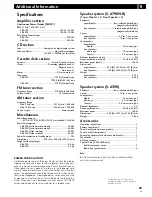
64
En
Additional Information
11
Using cassette tapes
The tape of a cassette is quite easily damaged and loose tape can
jam in the tape deck mechanism. If the tape has become
unwound, use a pen or pencil to wind it back on to the spool.
(C)
When not using cassettes, always store in the case. Store cassettes
away from magnetic fields, excessive heat, humidity, dust or oil.
Before recording on a tape, wind the tape on past the leader tape
(about the first 3 or 4 seconds of each side).
Tapes you should avoid
Since tapes longer than 90 minutes are so thin, they are more
susceptible to jamming in the tape deck mechanism and other
trouble such as irregular winding. Avoid using cassette tapes
longer than 90 minutes.
Protecting your recordings
You can protect an important recording against accidental erasure
by breaking the erase-protect tab(s) with a small screwdriver.
(D)
If you want to re-record on an erase-protected cassette, cover the
space left by the broken tab with self-adhesive tape.
(E)
Note (XR-A790 only):
If you’re using Type II (High/C
r
O
2
)
tapes, make sure you don’t also cover the tape-type detection
holes.
Don’t glue paper or put stickers on discs, or write on them using a
pencil, ball-point pen or other sharp-tipped writing instrument.
(A)
Discs to avoid
Discs spin at high speed inside the player during playback. If you
can see that a disc is cracked, chipped, warped, or otherwise
damaged, don’t risk using it — you could end up damaging the
unit.
This system is designed for use with conventional, fully circular
CDs only. Use of shaped discs is not recommended. Pioneer
disclaims all liability arising in connection with the use of shaped
discs.
(B)
(A)
(B)
(C)
Erase-protect tab (For side A)
Lengüeta de antigrabación
(para la cara A)
Erase-protect tab (For side B)
Lengüeta de antigrabación
(para la cara B)
(D)
Tape-type hole
Orificio de tipo de cinta
(E)









































